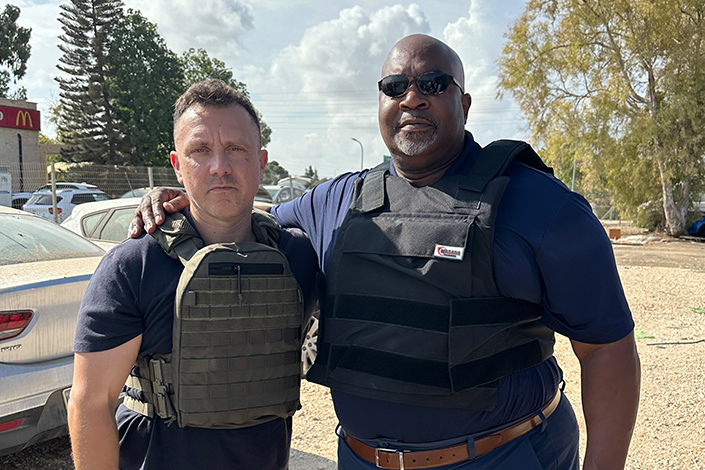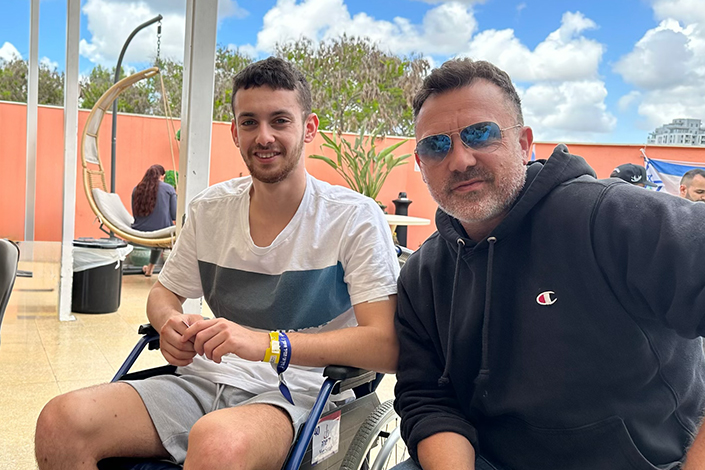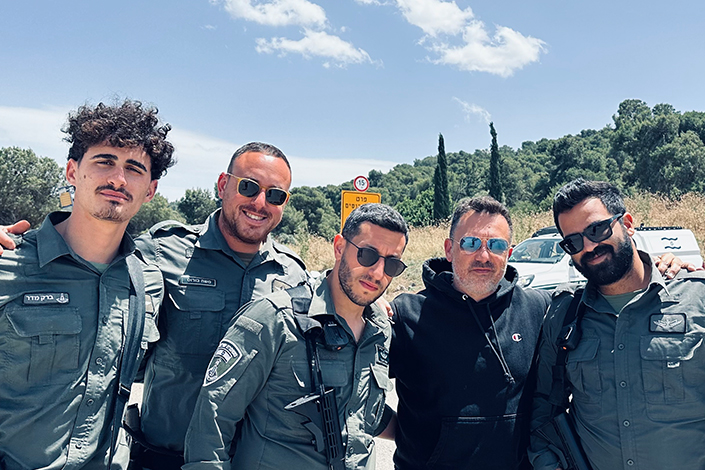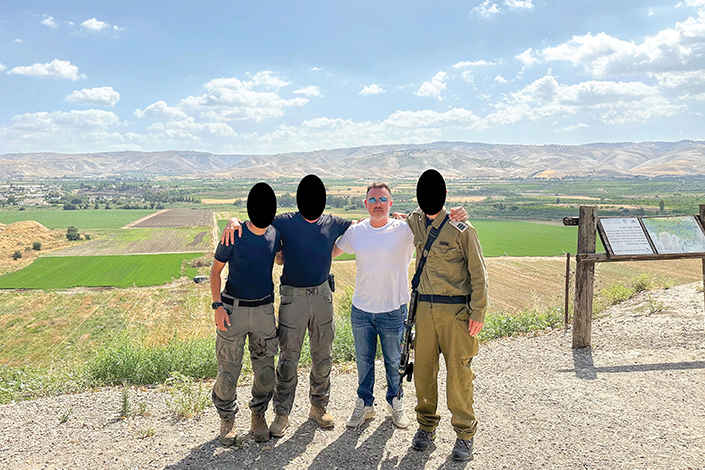By Maxim Fisher
“I need both of you to understand that when we go all the way north to the military base at Kav Ha’Imut, we could experience sniper fire from Hezbollah terrorists as we ascend the mountain. There is another road that the Israel Defense Forces (IDF) Corps of Engineers built, but it takes longer. So, what do you two gentlemen want to do?”
These are the words spoken to me and my travel partner, Mike Pregent, by an Israeli IDF reservist who had volunteered to be part of a unit that is keeping eyes on Israel’s northern border with Lebanon. It is May 2024, and we have just arrived for our nine-day journey in Israel.
Mike, who served under former director of the Central Intelligence Agency, General David Petraeus in Iraq, was a company commander in Afghanistan and worked for the Defense Intelligence Agency, replied, “When our time is up, our time is up, I guess.”
“Just drive as fast as you can,” I say, laughing.
The Northern Border
 I was born in the former Soviet Union into an anti-communist Jewish family. My mother wanted to immigrate to Israel. She had an uncle who was working as a scientist for the IDF at that time and filed for immigration to Israel with me, her then 4-year-old son. However, she changed her mind in Italy and decided she wanted to come to the U.S., where I grew up, instead.
I was born in the former Soviet Union into an anti-communist Jewish family. My mother wanted to immigrate to Israel. She had an uncle who was working as a scientist for the IDF at that time and filed for immigration to Israel with me, her then 4-year-old son. However, she changed her mind in Italy and decided she wanted to come to the U.S., where I grew up, instead.
With my family history in mind, I was honored to be asked by the Faith and Freedom Coalition to represent West Virginia along with three politicians from North Carolina, including Lieutenant Governor Mark Robinson, on a solidarity trip to Israel in early November 2023, not even a month after the atrocities had taken place right outside of the Gaza Strip, a Palestinian territory, on October 7.
My second trip to Israel with Mike this past May had more to do with understanding the military, intelligence and political dynamics of this war. We met with a volunteer reserve force in Kav Ha’Imut that serves as the eyes and ears of the IDF in that region. It is the first line of defense if Hezbollah, the Lebanese militant group, attacks Israel from southern Lebanon.
On Israel’s northern border, they have evacuated 80,000 to 100,000 residents from Kav Ha’Imut. These residents have been attacked by Hezbollah and many of their homes, schools and hospitals have been destroyed in recent months. As horrible as the damage inflicted by Hamas, the Palestinian militant group, has been in the south of Israel, Hezbollah is estimated to be 10 times more harmful. Hezbollah has between 60,000 and 100,000 soldiers, operates an arsenal of 200,000 rockets and is better trained and equipped than Hamas. Hezbollah, much like Hamas, is proxy built, designed, equipped and financed by Iran.
As Mike and I approached the border between Israel and Lebanon, we saw many kibbutzim, Israel’s communal villages, that were completely evacuated with empty playgrounds as all the kids are now miles from the border in fear for their lives.
Once we arrived at the IDF’s northern volunteer army base, we met with the rest of its reserve unit, comprised of men over the age of 35, to discuss the war. They told us they understand why so many people left, but somebody must watch the northern border as most soldiers and reservists are busy in the south dealing with the threat of Hamas in Gaza.
After they showed us their modest barracks and outlined for us previous Hezbollah missile attacks on large maps, we discussed local politics in Israel and how the U.S. election in 2024 was going to have a direct effect on this tiny country in the Middle East. Once we completed our meeting, our driver sped down the mountain once again, and we were lucky to avoid any sniper fire.
Later that day, Mike and I visited another IDF army base in the north and met with another unit that is responsible for research and development in reconnaissance.
This unit is building drones and gave us an example of what they can achieve in Gaza. They showed us a video where Hamas had abducted an Israeli K9, a Belgian Malinois, that was being tortured. The IDF located the house, called in precision missile strikes to eliminate two terrorists on top of the roof and two others outside of the house. Then an IDF counterterrorist unit came into the house, escorted the unarmed women out, found the dog and transported it to a field hospital. This operational precision in urban combat is unheard of and has never been done in the history of urban warfare.
Judea – Samaria
The following day, we visited the northern region of Judea and Samaria, also known as the West Bank, to meet with a counterterrorist unit near Jenin. Members of the unit took us along the border of Jordan and to the northern section of Judea and Samaria to show us where Hamas is still in operation.
We also met the Israeli border police who pointed out all the different regions in the mountainous area. Most Israeli politicians are not focused on the border with Jordan due to the peace treaty with the king of Jordan, but the king’s hold is tenuous.
The king is part of the Hashemites, who have been ruling Jordan since 1948.The biggest threat to Israel from the Jordanian border is the guns and rifles that get smuggled through local mafias and sold to the to the highest bidder, often terrorists. Since Gaza has been destroyed by the IDF as a proxy military base for Iran, Iran will likely start to infiltrate Jordan to use another proxy area against Israel.
Judea and Samaria and the area close to Jordan are some of the most beautiful places I’ve ever seen. It is really the land of the Bible. While for Mike and me it was a peaceful day, I was told by the counterterrorism IDF unit that this area could combust at any moment.
A Resilient People
 At our next stop, Mike and I went to a busy hospital north of Tel Aviv to meet with many IDF units recovering from wounds sustained in Gaza. We sat with many wounded warriors, one of whom was a 20-year-old who had been shot and survived shrapnel in his back and rib cage.
At our next stop, Mike and I went to a busy hospital north of Tel Aviv to meet with many IDF units recovering from wounds sustained in Gaza. We sat with many wounded warriors, one of whom was a 20-year-old who had been shot and survived shrapnel in his back and rib cage.
We sat with another wounded warrior who was a medic. Despite being shot and having shrapnel in his back, he continued to save the lives of many in his unit. He sat there with his close friends who came to visit, chain-smoking cigarettes and wearing a Metallica T-shirt. He had questions about the U.S. and expressed a desire to visit Arizona, Texas and Nevada. I could tell that while he was happy to be alive and recovering, all he wanted was to go back to Gaza and rejoin the fight. It was an honor to spend time with these young heroes.
We then visited Bring Them Home Now, an organization established immediately after the events of October 7 to address the needs of the families of hostages. We met with two individuals, a young man and a young woman, each with a sibling still being held hostage in Gaza.
Everyone in Israel wants to get the hostages back. However, many feel that Hamas is using the hostages as leverage to release hundreds of violent Palestinian prisoners and to draw the IDF into Gaza in an urban combat environment indefinitely. Bring Them Home Now advocates bringing back the hostages under almost all circumstances. I listened to the two young family members of hostages speak eloquently, holding back their tears and advocating for the release of their siblings.
Mike and I then visited an IDF combat engineering unit that specializes in demolitions and tunnel warfare. Because Gaza used billions of dollars in aid from around the world to build over 350 miles of underground tunnels instead of the infrastructure needed to support the area, this unit built replicas of the tunnels found in Gaza so they can practice tunnel warfare.
The second lieutenant, a young man no older than 23, speaking perfect English, took us down into the tunnels. He also showed us a fuel tank from one of the Ghadr ballistic missiles recovered from the Dead Sea that Iran had used to target Israel in April. We also saw hundreds of small improvised explosive weapons made locally in Gaza.
Unfortunately, the idea that has propagated in the U.S.—that there are some Hamas terrorists and mostly peaceful Palestinians in Gaza—is not accurate. Of those in Gaza, 85% support Hamas. The best way to think about Gaza is as a military base, originally constructed with Iranian help, disguising itself as a society for the purpose of destroying Israel. Every single aspect of life in Gaza is geared toward killing Jews, Christians and other Israelis. This includes schools that brainwash children, Hamas camps for 14-year-old boys to learn to use AK-47s and endless media propaganda.
The difference between this and the IDF’s targeting process is staggering. Unit members explained that the IDF is extremely focused on achieving a low casualty rate due to its strict rules of engagement.
Before demolishing a big building in Gaza, there is a whole unit in the IDF that texts and calls all the people in that block, telling them they need to leave. The IDF delivers pamphlets and employs drones informing Gazans where a safe corridor has been created. Then they drop a knock bomb, which does not demolish the building but shakes it, giving everyone inside another 20-minute warning to leave. Only then do they target and demolish the building. With smaller homes, the process is even more meticulous. They use drones to check for terrorists on the roof and outside and smaller drones to see who is inside. Once they have all eyes on the building, a IDF unit will destroy or apprehend the terrorists and take any unarmed women and children to a safe zone.
The IDF must demolish the houses afterward because if they do not, Hamas will come back and booby-trap it, causing the deaths of innocent civilians. Hamas then blames the IDF for the deaths. The IDF’s targeting process and care for civilians is unprecedented in human history and contributes to the increased casualty rate among IDF soldiers as they exceed international law standards of war.
If Israel wanted to carpet bomb Gaza out of existence, it could. Instead, it continues securing Gaza, street by street, block by block, until it destroys Hamas completely. Conversely, I saw video footage of Hamas picking up kids and shooting between their legs and over their shoulders at the IDF, using them effectively as body armor. IDF soldiers will not shoot back at the terrorists holding kids as shields. Another IDF rule of engagement is that its members are not allowed to shoot anyone not holding a rifle. Consequently, Hamas fighters will shoot at the IDF, drop their AK-47s and hide, only to pick up another AK-47 stored behind a house and repeat the process. These are difficult rules of engagement for the IDF, but its soldiers continue to fight this war with great honor.
As we were leaving, I asked to speak to the 23-year-old lieutenant privately. I told him that he is part of Israel’s greatest generation and in 20-30 years, young people like him will run the country, and Israel will be stronger than it has ever been. He shook my hand, thanked me and said he hoped I was right.
A 30,000-Foot View
Mike and I then had the honor of meeting with two generals, a major, a captain, two members of the Knesset and officers from Israeli intelligence agencies. Adding to the information we received from soldiers on the ground, the officers’ commentary on the war provided us with a 30,000-foot view of the current conflict as well. During our meeting we had the chance to ask about how Israel feels about Prime Minister Netanyahu, how such a security breach happened and what the future looks like for Gaza.
I was unable to find one person in Israel who currently likes Netanyahu, but everyone agreed he is the only one capable of running this war. Regarding security, Israel has been dealing with multiple enemies: Hezbollah, Hamas, terrorists in the Judea and Samaria, Palestinian criminals transporting guns through the Jordanian borders and the Houthis firing rockets into the southern tip of Israel—all of these proxies controlled by their main enemy, Iran. But it doesn’t stop there. Qatar is also against them, and because of Israel’s deep allegiance with the U.S., China and Russia, countries that generally would not have gotten involved in Israeli and Middle Eastern affairs are now also against Israel, and it proved to be too difficult to secure every border.
Many peacenik generals had also become complacent, believing that President Donald Trump’s Abraham Accords were the strategy that would invariably bring peace to the Palestinian conflict. These generals relied too heavily on artificial intelligence and other technology in securing Israel’s safety while discounting the human intelligence that was being reported signaling that Hamas’s intent to destroy Israel had never wavered. Many Israeli generals on the left still cannot seem to understand that the impetus for Hamas’s aggression is not resources, money or land, but radical Islam. I find this surprising and dangerous when even some Israeli IDF generals seem not to understand the neighborhood they exist in.
Concerning the future, after the war with Hamas is over, what has now united the left, center and right is the belief that a two-state solution is no longer viable. Everyone believes a patchwork solution will be needed to deal with the problem in Gaza, which will ultimately mean the IDF staying in Gaza for a couple of years and finding peace partners within the Palestinian community who can help lead Gaza into a better future. Another idea is to involve the United Arab Emirates and Bahrain in the process of removing Hamas and building Gaza. There are no easy answers, and the future is not clear.
Lastly, many think that the situation with Iran has been kicked down the road for generations. Sooner or later, one of the Knesset members told me, Iran will have to be dealt with as it is the puppet master behind its proxies.
The biggest concern among the group is whether the U.S. is still supporting Israel unequivocally. Israel has long felt that world opinion does not matter if the U.S. Congress is with them. Now they are not so sure, and this is a great existential dilemma for Israelis as they do not want to lose their partnership with the U.S. Because of its strong allegiance with the U.S., Israel started to rely on American weapon supplies, ammunition and other resources to such an extent that they found they were not able to get parts and ammunition for this current war. This is something that is going to have to change, as the country cannot be left without ammunition. Specifically, Israel’s main concern is to shut down the United Nations Relief and Works Agency (UNRWA)—the Hamas wing of the United Nations whose buildings masquerade as entry points to the 350 miles of terror tunnels throughout Gaza.
Lastly, we learned that Israel is united in eradicating Hamas. They have disagreements about tactics and timelines, but ultimately everyone is united on this front. Hamas can no longer exist on their southern border, and they are willing to sacrifice everything if that is what they must do.
For our final stop, Mike and I met with a former commander of a special forces unit similar to our Navy Seals. After his service in the IDF, he went on to become a psychologist and is volunteering his time helping many IDF soldiers deal with PTSD after their time in Gaza.
I asked the commander how the IDF troops in Gaza feel about world opinion. He explained that most of them are not focused on world opinion but rather focused on making sure they are following the strict IDF doctrine. He said they know the world is under many false impressions on what goes on in Israel, but they know what they are doing is completely right in defending their homeland.
Recently, we all have seen the pro-Hamas demonstrations in the U.S. We have also seen our youth posting their admiration of Osama bin Laden on TikTok. Americans need to understand that we are at war. The false information war is being waged by Iran, Qatar, Syria, Hezbollah, Hamas, China, Russia and the Marxist Left. Millions of dollars are channeled into our country to brainwash the minds of our citizens, who have the luxury of the Atlantic Ocean separating us from the insanity that is radical Islam, with the intent of destroying our country from within.
Americans need to understand the following: This war is not about land. It is not about gaining resources. It is not about the delineation of borders. Israel is not occupying Gaza. Israel left in 2005. Gaza gets billions of dollars from the international community, including the U.S. Hamas chooses to use that money for rockets, building military installations under hospitals and UNRWA schools and making sure their leadership, living in the safety of Qatar, is worth billions of dollars. Jews, however, did live in Iraq, Yemen, Syria and many other Arab lands and were forced to leave in large numbers in 1948 during Israel’s war of independence.
Israelis are not involved in a genocide of the Arab people, as the Arab population does nothing but grow in the land of Israel, Judea and Samaria and Gaza. America needs to understand that not once since 1948 has Israel started any of these wars with its Arab neighbors. Everything that it has done has been in reaction to the existential threat against it. Americans should understand, that “from the river to the sea” means the genocide and killing of all Jews in the land of Israel. Evidenced by October 7, that is exactly what these radical Islamists would do if given the chance. I ask all Americans to stand unequivocally with Israel. I ask all Americans to buy Israeli war bonds. I need all Americans to understand that the IDF is not only protecting Israel but our country as well because this war is a clash of civilizations: radical Islam versus western civilization.
Editor’s Note:
Please note that the names of individuals mentioned in this story have been omitted to protect their identities due to the sensitive nature of their work.
 Maxim Fisher
Maxim Fisher
Maxim Fisher is the ambassador to Israel for the West Virginia Faith & Freedom Coalition. Fisher has consulted several officials and organizations, including the West Virginia Republican Party, and has a background in investigatory research. Fisher is the founder and deputy director of War Dog Guardians, a 501c(3) nonprofit that works to serve and find homes for K-9s leaving the U.S. military. He recently completed a 9-day trip to Israel with Michael Pregent, the leading counter terrorist expert with the Hudson Institute.










